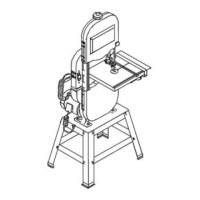— Support the blade and keep it from
twisting during operation. Blade guides must be adjusted
when blade is changed or replaced.
blade tension when changing blades.
— Adjusts blade position so
blade always runs in the center of the wheel.
— Has a built-in child safety lock. To
lock the switch in the OFF position, remove the switch
—Removal of waste material by a cut from
the outside edge, allowing easier cutting of intricate
— Helps keep the machine free from
sawdust. The sawdust port makes an excellent hook-up
— Locks the table in place.
— Shows the degree the table is
tilted for bevel cutting.
Use it after adjusting the upper guide assembly to make
sure upper blade guide just clears workpiece before
cutting. Upper guide lock knob must be tightened before
the band saw is turned on.
— An angle cut made through the face of a
— A simultaneous bevel and miter
— A cut made across the width of the
— Performing a cut without using a fence
(guide), hold-down or other proper device to prevent the
workpiece from twisting during the cutting operation.
— A sticky sap-based residue from wood
— Misalignment of the blade.
— The material removed by the blade in a
through cut, or the slot produced by the blade in a non-
— The front edge of the workpiece
pushed into the cutting tool fi rst.
— An angle cut made across the width of a
— A cutting operation to reduce the thickness
of the workpiece to make thinner workpiece.
— A sticky sap that has hardened.
— A cutting operation along the length of
— The area of the workpiece or
table top directly in line with the travel of the blade or the
part of the workpiece that will be cut.
— The distance between two saw blade teeth tips,
that are bent outward in opposite directions to each
The further apart the tips are, the greater the set.
— The workpiece edge last cut by the
— The item being cut. The surfaces of a
workpiece are commonly referred to as faces, ends and
— The surface on which the workpiece
rests while performing a cutting or sanding operation.

